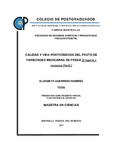| dc.contributor.author | Guerrero Ramírez, Elizabeth | |
| dc.creator | GUERRERO RAMÍREZ, ELIZABETH; 559006 | |
| dc.date.accessioned | 2019-08-20T13:26:18Z | |
| dc.date.available | 2019-08-20T13:26:18Z | |
| dc.date.issued | 2017-04 | |
| dc.identifier.uri | http://hdl.handle.net/10521/3840 | |
| dc.description | Tesis (Maestría en Ciencias, especialista en Fisiología Vegetal).- Colegio de Postgraduados, 2017. | es_MX |
| dc.description.abstract | México es uno de los principales productores y exportadores de fresa a nivel mundial. Sin embargo, nuestro país depende de variedades generadas y protegidas en Estados Unidos de América, por las que se debe pagar costos de importación y regalías. En México existen variedades de fresa registradas ante el Servicio Nacional de Certificación e Inspección de Semillas (SNICS) de la Secretaría de Agricultura, Ganadería, Desarrollo Rural, Pesca y Alimentación (SAGARPA), las cuales pueden ser rentables en el sistema producto fresa, pero se desconoce su comportamiento postcosecha. Por lo anterior, el objetivo de esta investigación fue evaluar grado de madurez óptimo para obtener la máxima calidad en la cosecha y el tiempo de frigoconservación para lograr la máxima vida postcosecha en variedades mexicanas de fresa. Se encontró que a la cosecha, el fruto de fresa cosechado en ¾ de madurez comparado con la fruta completamente madura es más firme, y puede o no tener ligeramente más sólidos solubles totales. Se encontró que en todos los parámetros evaluados, una o más variedades mexicanas igualan o superan a la variedad comercial Festival. Durante el almacenamiento postcosecha, los frutos cosechados con ¾ de madurez presentaron mayor firmeza y mayor luminosidad y pureza de color, pero menor contenido de sólidos solubles totales, comparados con los frutos cosechados en plena madurez, lo que confiere mejor calidad para comercialización al fruto cosechado con ¾ de madurez. La calidad se deteriora rápidamente a temperatura ambiente, especialmente por la pérdida de peso y de firmeza. En frigoconservación a 1°C se mantiene la calidad durante cuatro días, pero se deteriora la fruta relativamente rápido cuando se saca a temperatura ambiente. Con dos días a temperatura ambiente, ya sea con o sin refrigeración previa, la firmeza se reduce significativamente. _______________ FRUIT QUALITY AND POSHARVEST OF MEXICAN VARIETIES OF STRAWBERRY (Fragaria x ananassa Duch.). ABSTRACT: Mexico is one of the leading producers and exporters of strawberries worldwide. However, this country depends on the varieties bred and protected in the United States of America, then import and royalties must be paid. In Mexico, several strawberry varieties were registered in the National Seed Certification and Inspection Service (SNICS) of the Secretariat of Agriculture, Livestock, Rural Development, Fisheries and Food (SAGARPA), which may be profitable for the strawberry industry, but their postharvest behavior is unknown. Therefore, the objective of this research was to determine the optimum degree of maturity to obtain maximum fruit quality at harvest and preserve fruit quality during cold storage in Mexican strawberry varieties. At harvest, strawberry fruit harvested at 75% maturity is firmer than the fully-ripe fruit, and may or may not have a little more total soluble solids. It was found that in all the evaluated parameters, one or more Mexican varieties equal or surpass the commercial variety Festival. During post-harvest storage, fruits harvested at ¾ maturity showed greater firmness and greater color luminosity and purity but lower total soluble solids content, compared to fruits harvested at full maturity, which confer higher quality for commercialization to fruit harvested at ¾ maturity. Fruit quality deteriorates rapidly at room temperature, especially due to weight and firmness loss. In cold storage at 1°C, fruit quality is maintained for four days, but the fruit deteriorates quickly when it is transferred to room temperature. Two days at room temperature, with or without cold storage, the firmness is significantly reduced. | es_MX |
| dc.description.sponsorship | Consejo Nacional de Ciencia y Tecnología (CONACyT). | es_MX |
| dc.format | pdf | es_MX |
| dc.language.iso | spa | es_MX |
| dc.rights.uri | http://creativecommons.org/licenses/by-nc-nd/4.0 | es_MX |
| dc.subject | Grado de madurez | es_MX |
| dc.subject | Frigoconservación | es_MX |
| dc.subject | Almacenamiento | es_MX |
| dc.subject | Firmeza del fruto | es_MX |
| dc.subject | Color del fruto | es_MX |
| dc.subject | Degree of maturity | es_MX |
| dc.subject | Cold storage | es_MX |
| dc.subject | Storage | es_MX |
| dc.subject | Fruit firmness | es_MX |
| dc.subject | Fruit color | es_MX |
| dc.subject | Fisiología Vegetal | es_MX |
| dc.subject | Maestría | es_MX |
| dc.subject.classification | CIENCIAS AGROPECUARIAS Y BIOTECNOLOGÍA::CIENCIAS AGRARIAS::HORTICULTURA::FRUTICULTURA | es_MX |
| dc.title | Calidad y vida postcosecha del fruto de variedades mexicanas de fresa (Fragaria x ananassa Duch). | es_MX |
| dc.type | Tesis | es_MX |
| Tesis.contributor.advisor | Cruz Huerta, Nicacio | |
| Tesis.contributor.advisor | Calderón Zavala, Guillermo | |
| Tesis.contributor.advisor | Saucedo Veloz, Crescenciano | |
| Tesis.date.submitted | 2017-04 | |
| Tesis.date.accesioned | 2017 | |
| Tesis.date.available | 2017 | |
| Tesis.format.mimetype | pdf | es_MX |
| Tesis.format.extent | 1,043 KB | es_MX |
| Tesis.subject.nal | Fragaria ananassa | es_MX |
| Tesis.subject.nal | Ensayos de variedades | es_MX |
| Tesis.subject.nal | Variety trials | es_MX |
| Tesis.subject.nal | Fisiología postcosecha | es_MX |
| Tesis.subject.nal | Postharvest physiology | es_MX |
| Tesis.subject.nal | Calidad de la fruta | es_MX |
| Tesis.subject.nal | Fruit quality | es_MX |
| Tesis.subject.nal | Cosecha | es_MX |
| Tesis.subject.nal | Harvesting | es_MX |
| Tesis.subject.nal | Sólidos solubles totales | es_MX |
| Tesis.subject.nal | Total soluble solids | es_MX |
| Tesis.subject.nal | Valor nutritivo | es_MX |
| Tesis.subject.nal | Nutritive value | es_MX |
| Tesis.rights | Acceso abierto | es_MX |
| Articulos.subject.classification | Fresas | es_MX |
| dc.type.conacyt | masterThesis | es_MX |
| dc.identificator | 6||31||3107||310704 | es_MX |
| dc.contributor.director | CRUZ HUERTA, NICACIO; 37482 | |
| dc.audience | generalPublic | es_MX |


